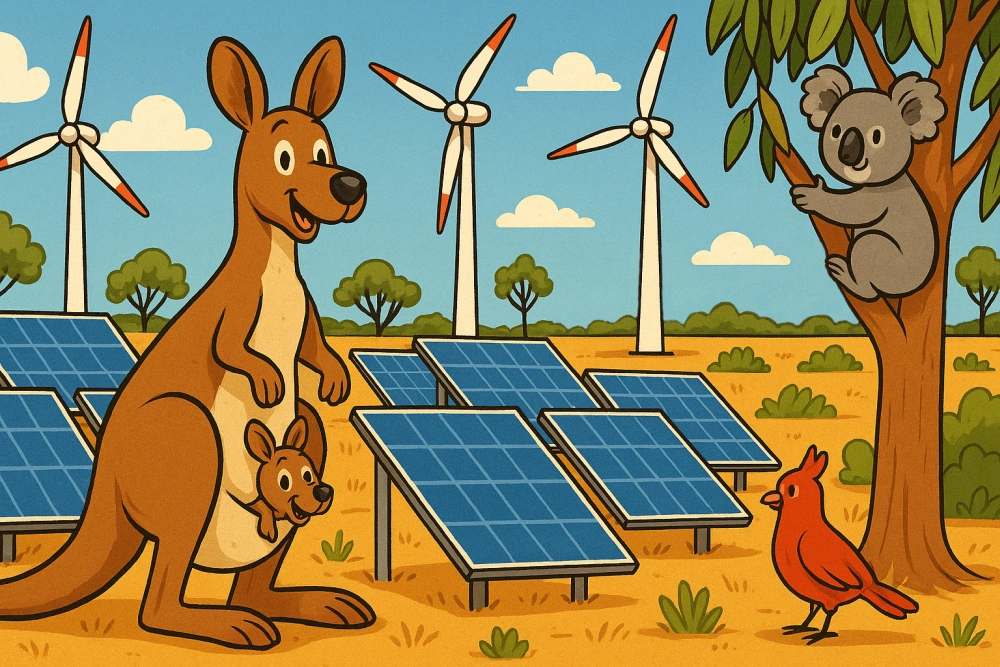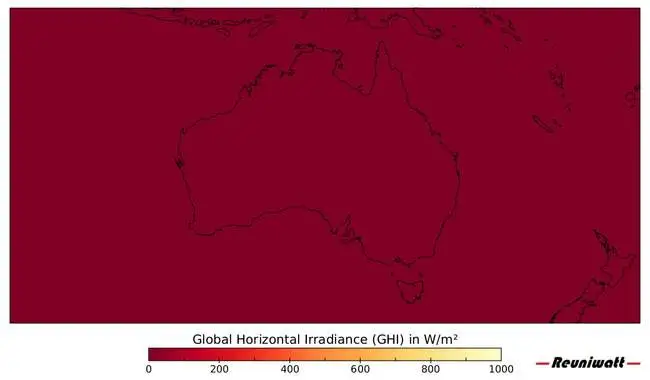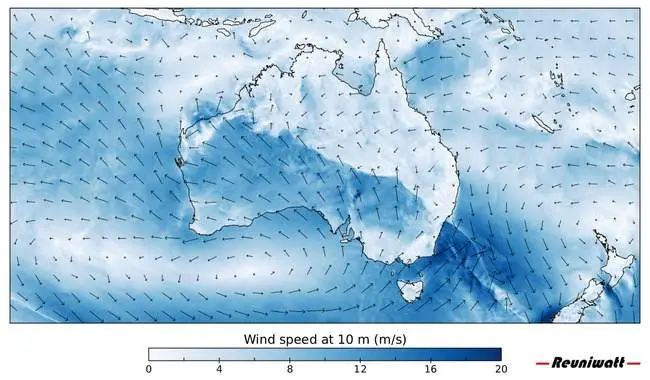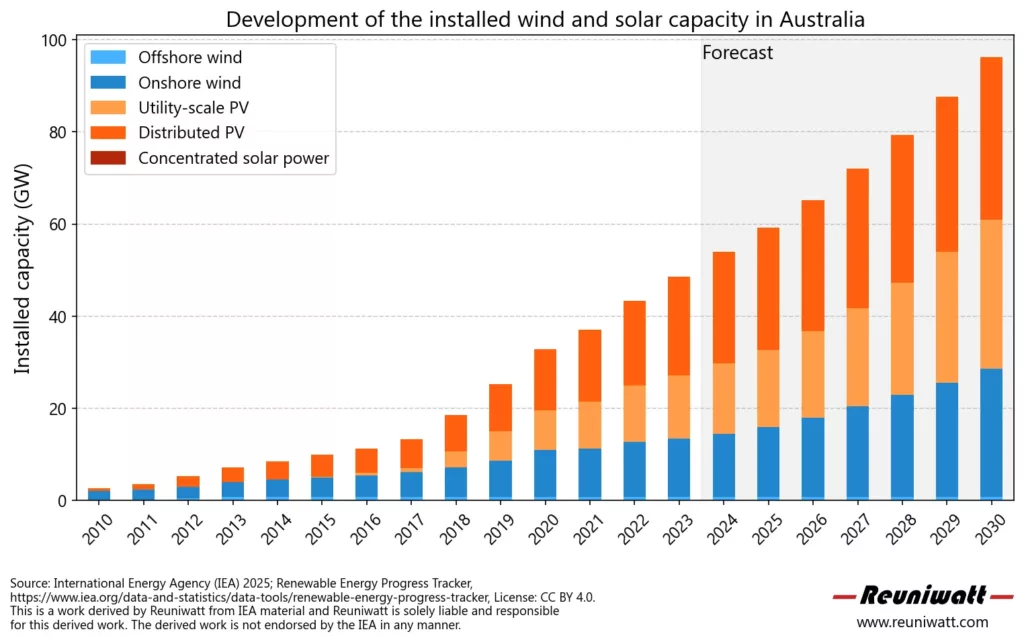Australia, rich in natural resources and vast open spaces, is establishing itself as a key player in the global energy transition. With rapid growth in solar and wind power capacity, the country is taking advantage of exceptional weather conditions to accelerate its shift towards renewable energies. However, despite major advances, challenges remain, particularly in terms of grid integration and energy policies.
Renewables market in Australia
Australia’s renewable energy market has seen rapid growth over the past decade, driven by a combination of government policies, falling technology costs, and strong investor interest. With its vast landmass and abundant natural resources, Australia is particularly well-positioned for solar and wind energy development. As of 2024, renewables account for more than 35% of the country’s electricity generation, with solar and wind leading the way. Rooftop solar is especially dominant, with over 3.5 million Australian households installing solar panels, making the country one of the global leaders in solar adoption per capita. Large-scale wind and solar farms are also expanding, particularly in states like New South Wales, Victoria, and South Australia, where strong policy support and grid infrastructure improvements have facilitated new projects. However, the rapid increase in renewable capacity has also highlighted the need for grid modernization and energy storage solutions to manage variability and ensure a stable power supply.
One of the key challenges in Australia’s transition to renewables is its reliance on coal, which still supplies a significant portion of the national electricity grid. While coal-fired power stations are gradually being phased out, the speed of transition remains a concern, particularly for regions economically dependent on fossil fuel industries. The Australian Energy Market Operator (AEMO) has outlined plans to ensure grid reliability as coal plants retire, emphasizing the need for large-scale energy storage, pumped hydro projects, and enhanced transmission networks. Additionally, Australia is investing in emerging technologies such as hydrogen, with a strong focus on becoming a global exporter of green hydrogen, leveraging its renewable energy potential to supply international markets.
Despite these challenges, Australia is on track to significantly increase its renewable energy share, with ambitious federal and state-level targets driving further investment. The federal government has committed to achieving net zero emissions by 2050, while several states, including Victoria and South Australia, have set even more aggressive renewable energy goals. Offshore wind is emerging as a new frontier, with projects planned along the southern coastline, and the expansion of transmission infrastructure will be key to unlocking further renewable potential. Additionally, corporate demand for clean energy is rising, with businesses and industries increasingly signing power purchase agreements (PPAs) to secure renewable electricity. As technological advancements continue to improve the efficiency and affordability of renewables, Australia is poised to transition to a cleaner and more resilient energy system, positioning itself as a leader in the global renewable energy transition.

Wind and solar capacities in Australia
As of 2023, renewable energy sources contributed 35% of Australia’s total electricity generation, respectively, with solar power accounting for 16% and wind power 12%. This marks a 3% increase from 2022, setting a new record for the highest share of renewable generation in the country’s history. In terms of installed capacity, Australia added approximately 3.9 gigawatts (GW) of solar power in 2022, bringing the total solar capacity to around 26.8 GW. Notably, utility-scale solar comprises 28% of this capacity, while the majority stems from residential rooftop installations. We can observe below that Australia’s irradiance is a key asset for the country’s renewables production.

Wind energy has also seen substantial growth, with generation increasing by 6% in 2023 and an average annual growth rate of 13% since 2015. The combined efforts in expanding both wind and solar capacities have been pivotal in Australia’s renewable energy advancement.

Renewable energy market projections for Australia
Australia’s renewable energy sector is poised for significant growth in the coming years, driven by ambitious government targets and substantial investments. The federal government aims to achieve 82% renewable electricity generation nationally by 2030. In line with this objective, projections indicate that the National Energy Market (NEM) will see an average of 42% renewable generation in 2024, up from 39% in 2023.
The International Energy Agency (IEA) forecasts an 85% expansion in Australia’s renewable energy capacity by 2027, reaching 40 gigawatts (GW). This growth is attributed to the introduction of ambitious targets, increased clean energy funding at both federal and state levels, power purchase agreements (PPAs), and new projects within renewable energy zones (REZ). If Australia can accelerate the implementation of REZs and related grid projects, alongside additional coal retirements, the IEA anticipates achieving 57 GW of renewable electricity capacity by 2027.

In terms of specific technologies, both wind and solar power are expected to see substantial increases. Between 7.2 and 7.5 GW of new wind and solar capacity is projected to be added under the Renewable Energy Target (RET) for 2024, potentially surpassing the previous record of 7.16 GW set in 2020.
Overall, the installed renewable energy capacity in Australia is expected to grow from 51 GW in 2024 to 89 GW by 2029, representing a compound annual growth rate (CAGR) of 11.61% during this period.
Our activities in Australia
Reuniwatt has been active in Australia for more than a decade and is committed to accompany Australian companies in the energy transition. Reuniwatt had already deployed sky cameras in Australia and is actively looking for collaboration with local actors on the energy market to improve intraday solar and wind forecasting as well as day-ahead solar and wind forecasting and boost assets’ performances. We are present in Oceania and we are committed to expand our activities in the region.